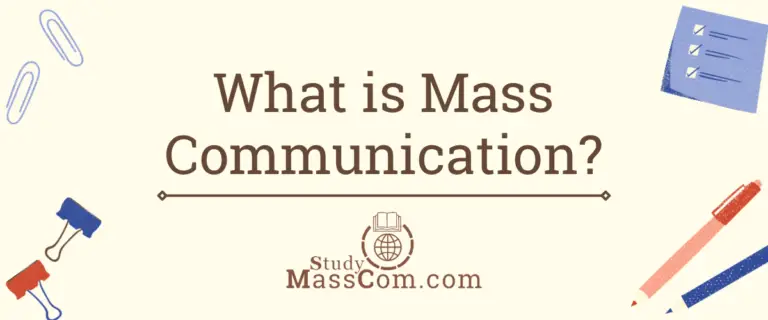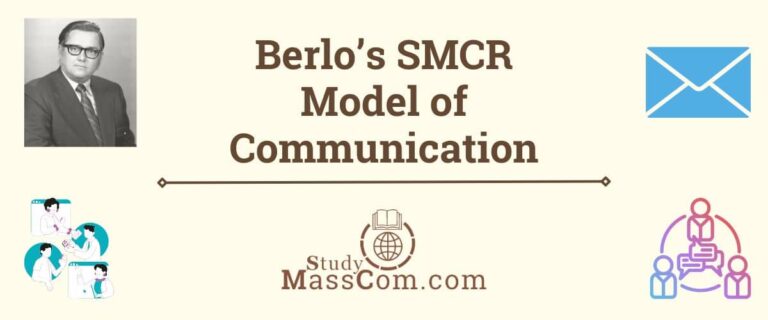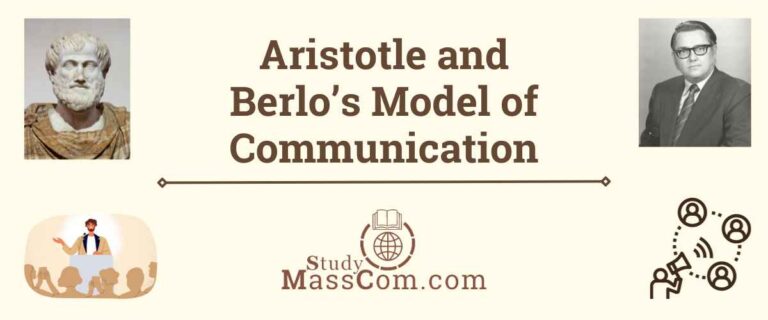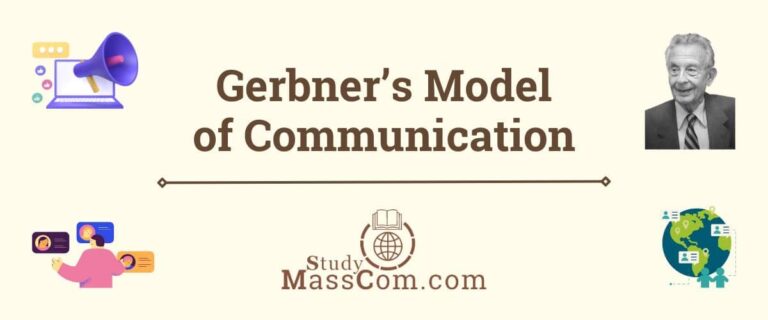Aristotle’s vs. Lasswell’s Models of Communication: Similarities and Differences
Aristotle, the ancient Greek philosopher, laid the foundation for understanding communication with his insightful model. Rooted in the art of rhetoric and persuasion, Aristotle’s model emphasizes the dynamics between the communicator, the message, and the audience. At its core, Aristotle’s model seeks to explore how effective communication can sway opinions, inspire action, and connect individuals. On the other hand, Harold Lasswell, a prominent communication scholar, contributed a concise yet insightful model that breaks down the communication process into fundamental components. Known as the “Lasswell’s Formula,” his model centers on addressing five key questions, each representing a crucial aspect of communication.
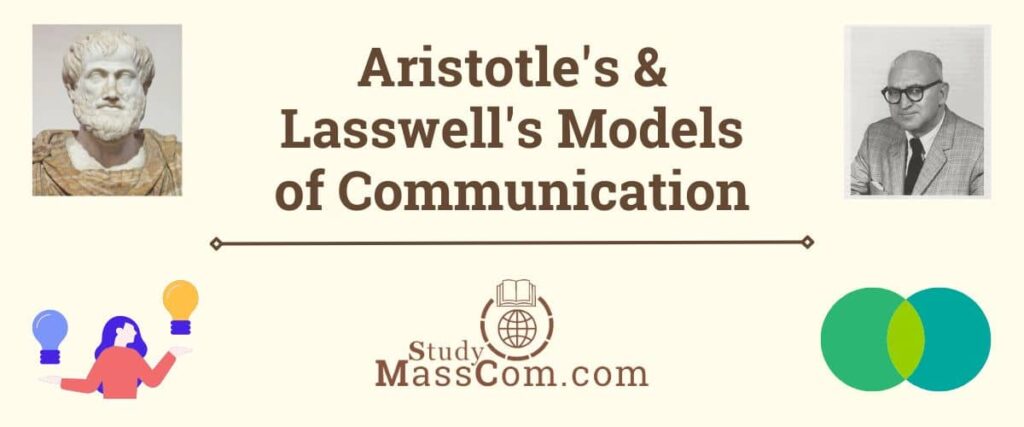
Overview of Aristotle’s Model of Communication
In Aristotle’s view, effective communication involves three essential elements:
Speaker (Orator)
The communicator holds a pivotal role in Aristotle’s model. The orator, through the art of persuasion, aims to establish credibility, evoke emotions, and provide logical reasoning to captivate the audience’s attention.
Speech (Message)
The content of the message is equally significant. Aristotle recognized three distinct persuasive appeals that contribute to a compelling message: logos (logical appeal), pathos (emotional appeal), and ethos (credibility and character appeal). The crafting of an impactful message involves a delicate interplay of these appeals.
Audience
The audience forms the receiving end of the communication process. Aristotle underscored the importance of understanding the audience’s beliefs, values, and emotions to tailor the message effectively. Adapting the message to resonate with the audience’s unique characteristics enhances the likelihood of successful communication.
Aristotle’s model has not only withstood the test of time but also serves as a foundation for modern communication theories that explore the intricate relationship between persuasion, rhetoric, and effective messaging.
Overview of Lasswell’s Model of Communication
Lasswell’s communication model comprises the following elements:
Who
This question pertains to the sender or source of the message. It underscores the importance of identifying and understanding the communicator’s role in shaping the message.
Says What
The content of the message itself takes center stage here. Lasswell’s model emphasizes the significance of the information, ideas, or emotions being conveyed to the audience.
In Which Channel
The medium or channel through which the message is transmitted holds relevance. Lasswell recognizes that the choice of communication channel influences the reception and impact of the message.
To Whom
The intended audience or receivers of the message constitute a vital aspect of the communication process. Understanding the audience’s characteristics, preferences, and expectations contributes to effective communication.
With What Effect
Lasswell’s model concludes by delving into the desired outcome of communication. It prompts us to consider the impact, influence, or response that the message aims to achieve from the audience.
Lasswell’s succinct model provides a framework for analyzing communication processes across diverse contexts, guiding scholars and practitioners in comprehending the essential elements that contribute to the effective transmission and reception of information. In essence, both Aristotle’s and Lasswell’s models offer valuable insights into the multifaceted nature of communication, spanning from the art of persuasion to the fundamental components that underpin effective interaction.
Similarities Between Aristotle’s and Lasswell’s Models of Communication
While Aristotle’s and Lasswell’s models of communication originate from different time periods and perspectives, they do share some similarities in their fundamental approach to understanding the communication process. Here are the key similarities between the two models:
Emphasis on Elements and Components
Both models highlight the essential components of communication. Aristotle’s model focuses on the roles of the speaker, speech, and audience, while Lasswell’s model breaks down communication into the sender, message, channel, receiver, and effect. Both models recognize the importance of these basic elements in the communication process.
Audience-Centric Approach
Both models acknowledge the significance of the audience or receiver in the communication process. Aristotle emphasizes understanding the audience’s beliefs and emotions to tailor the message effectively, while Lasswell’s model includes a specific question about the intended recipients of the message. Both models recognize that successful communication requires consideration of the audience’s characteristics and preferences.
Impact and Effect
Both models address the desired impact or effect of communication. Aristotle’s model emphasizes persuasion and influencing the audience’s beliefs and actions through emotional and logical appeals. Lasswell’s model explicitly asks about the intended effect of the message. Both models acknowledge that communication is not solely about transmitting information but also about achieving a specific outcome.
Practical Application
Both models have practical applications in various communication contexts. Aristotle’s model has been used as a basis for understanding persuasive communication and rhetoric, guiding effective public speaking and argumentation. Lasswell’s model provides a structured framework for analyzing communication processes and designing messages for specific purposes and audiences.
Simplicity and Clarity
Both models are relatively simple and straightforward, making them accessible for students, researchers, and practitioners of communication. They provide concise frameworks that can be easily applied to analyze and understand different communication situations.
Foundational Influence
Both models have had a lasting influence on the field of communication theory and practice. Aristotle’s insights into persuasion and rhetoric have informed numerous subsequent theories and approaches. Lasswell’s concise formula continues to be a starting point for discussions on the essential components of communication.
In summary, while Aristotle’s and Lasswell’s models of communication differ in their historical contexts and emphases, they share common ground in their recognition of key elements, audience-centric approach, focus on impact, practical applicability, simplicity, and lasting influence on the study of communication.
Differences Between Aristotle’s and Lasswell’s Models of Communication
Aristotle’s and Lasswell’s models of communication differ in terms of historical context, emphasis, components, focus on persuasion vs. information, depth, communication channel, complexity, and outcome. While both models contribute valuable insights to the study of communication, they approach the subject from distinct angles and serve different purposes. Here are the key differences between the two models:
Historical Context and Origin
Aristotle’s model of communication dates back to ancient Greece (4th century BCE) and is rooted in the art of persuasion and rhetoric. Lasswell’s communication model emerged in the 20th century (1948) within the field of political science and communication studies, reflecting a more modern and systematic approach.
Emphasis and Purpose
Aristotle’s model emphasizes persuasive communication and the art of rhetoric. It focuses on influencing and changing the beliefs, emotions, and actions of the audience. Lasswell’s model is more concerned with analyzing the components and functions of communication, aiming to provide a structured framework for understanding the transmission and reception of information.
Components
Aristotle’s model includes the speaker (orator), speech (message), and audience as its primary components. Lasswell’s model breaks down communication into five key components: who (sender), says what (message), in which channel (medium), to whom (receiver), and with what effect (outcome).
Persuasion vs. Information
Aristotle’s model places a strong emphasis on persuasive appeals, including emotional (pathos) and logical (logos) elements, to change the audience’s perspective or behavior. Lasswell’s model does not explicitly address emotional appeals. It focuses more on conveying information, ideas, or messages from the sender to the receiver.
Explore this comparative analysis of Cultivation Theory and Agenda-Setting Theory.
Depth and Detail
Aristotle’s model offers a deeper exploration of persuasive techniques and strategies, including ethos, pathos, and logos, as well as the art of crafting convincing arguments. Lasswell’s model is more concise and straightforward, consisting of a series of basic questions that highlight essential aspects of communication.
Communication Channel
Aristotle’s model does not explicitly address the medium or channel through which communication occurs. Lasswell’s model includes the “in which channel” question, recognizing the significance of the communication medium in the process.
Complexity and Application
Aristotle’s model is more complex and is often associated with the art of public speaking, persuasion, and rhetoric. Lasswell’s model is relatively simpler and serves as a starting point for analyzing various communication situations, including political communication.
Focus on Outcome
Aristotle’s model aims to achieve specific outcomes by influencing the audience’s attitudes and behaviors through persuasive techniques. Lasswell’s model explicitly includes a question about the intended effect of the message, highlighting the importance of considering the impact of communication.
Also, check out the similarities and differences between Two-Step Flow Theory and Multi-Step Flow Theory.
Conclusion
In a world where communication continues to evolve through technology, media, and cultural shifts, Aristotle’s and Lasswell’s communication models remain relevant touchstones. Aristotle’s insights into the art of rhetoric remind us of the enduring power of compelling storytelling and emotional resonance. Lasswell’s formulaic approach serves as a starting point for dissecting modern communication channels and their effects on individuals and societies.
In essence, Aristotle’s and Lasswell’s models of communication stand as timeless pillars in the study of human interaction. Their enduring significance lies in their ability to illuminate the intricate threads that connect speakers, messages, mediums, audiences, and effects. As we navigate the ever-changing landscape of communication, these models remain valuable guides, offering us a deeper understanding of the mechanisms that shape our world through the spoken and written word.
You can also read about the Magic Bullet Theory and the Magic Multiplier Approach in Development Communication.
FAQs
The Aristotle Model of Communication emphasizes persuasive rhetoric, involving the orator, emotional appeals, and logical reasoning to influence the audience. In contrast, Harold Lasswell’s model focuses on structured analysis, breaking communication into five components: sender, message, channel, receiver, and effect. While Aristotle’s model explores the art of persuasion, Lasswell’s approach provides a systematic framework for dissecting information transmission and reception, making it a foundation for understanding communication dynamics in a broader range of contexts.
Aristotle’s and Lasswell’s communication models share a focus on essential components. Both models recognize the pivotal role of the sender or speaker, the significance of the message itself, and the importance of the audience or receiver. While Aristotle’s model emphasizes persuasive appeals and emotional connection, Lasswell’s communication model provides a structured breakdown by posing questions about the sender, message, channel, receiver, and effect. In essence, both models acknowledge the interplay between these core elements, emphasizing their role in effective communication, whether through persuasion or information transmission, while guiding scholars and practitioners in understanding and analyzing communication processes.

